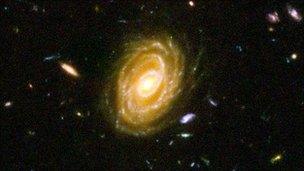New method 'confirms dark energy'
- Published

One type of observation measured a pattern in the distribution of galaxies
First results from a major astronomical survey using a cutting-edge technique appear to have confirmed the existence of mysterious dark energy.
Dark energy makes up some 74% of the Universe and its existence would explain why the Universe appears to be expanding at an accelerating rate.
The finding was based on studies of more than 200,000 galaxies.
Scientists used two separate kinds of observation to provide an independent check on previous dark energy results.
Two papers by an international team of researchers have been accepted for publication in the Monthly Notices of the Royal Astronomical Society, external journal.
One type of observation used by the astronomers involves measuring a pattern in how galaxies are distributed in space, external. This pattern is known by the term "baryon acoustic oscillations".
The second type of observation involves measuring how quickly clusters of galaxies have formed over time, external. Both of these techniques confirmed the existence of dark energy and the acceleration in the expansion of the Universe.
The concept of dark energy was first invoked in the late 1990s by studying the brightness of distant supernovas - exploding stars.
Einstein was right
To explain why the expansion of the Universe was speeding up, astronomers had to either rewrite Albert Einstein's theory of gravity or accept that the cosmos was filled with a novel type of energy.
"The action of dark energy is as if you threw a ball up in the air, and it kept speeding upward into the sky faster and faster," said co-author Dr Chris Blake of the Swinburne University of Technology in Melbourne, Australia.
"The results tell us that dark energy is a cosmological constant, as Einstein proposed. If gravity were the culprit, then we wouldn't be seeing these constant effects of dark energy throughout time."

The Anglo-Australian telescope was used in the galaxy survey
The latest findings have come from a galaxy survey project called WiggleZ, which began in 2006 and finished this year. WiggleZ used data from Nasa's Galaxy Evolution Explorer (Galex) space telescope and the Anglo-Australian Telescope on Siding Spring Mountain in Australia.
The survey mapped the distribution of galaxies in an unprecedented volume of the Universe, looking eight billion years back in time - more than half the age of the Universe.
Cosmologist Bob Nicholl, who was not involved with the research, told BBC News: "This is a major step forward. These guys are serious, major scientists and we've been waiting for this result for some time.
The professor of astrophysics at Portsmouth University, UK, added: "It's re-confirmation of dark energy, it gives us another data point to fit our theories around and it shows us the way to the future. More astronomers are going to be doing this in years to come."
While dark energy makes up about 74% of the Universe, dark matter - which does not reflect or emit detectable light - accounts for 22%. Ordinary matter - gas, stars, planets and galaxies - makes up just 4% of the cosmos.
However, despite scientists being able to infer the existence of dark energy and dark matter, these phenomena still elude a full explanation.
Paul.Rincon-INTERNET@bbc.co.uk
- Published24 November 2010